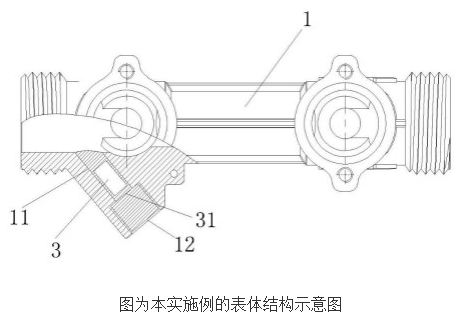Today, I will introduce a national invention authorized patent-ring type ultrasonic heat meter. The patent was applied for by Zhejiang Yongyang Energy Conservation Technology Co., Ltd., and the authorization was announced on April 19, 2017.
Content descriptionThe utility model relates to a heat meter, in particular to a ring-type ultrasonic heat meter.
Background of the inventionThe heat meter is an instrument for calculating heat. The working principle of the heat meter: install a pair of temperature sensors on the up and down pipes that pass the heat-carrying fluid, and install the flowmeter on the fluid inlet or return pipe (different installation positions of the flowmeter will result in different final measurement results. ), the flow meter sends out a pulse signal proportional to the flow rate, a pair of temperature sensors give an analog signal indicating the temperature, and the integrator collects the signals from the flow rate and temperature sensors, and uses the integration formula to calculate the heat obtained by the heat exchange system .
However, because there are some impurities in the water cycle, when measuring the flow rate, using a traditional flow meter will affect the accuracy of the test results. The hot water causes a relatively large resistance, and the debris is easy to damage the sensor and cause a decrease in the service life. .
Summary of the inventionThe purpose of the utility model is to provide a ring-type ultrasonic heat meter with long service life and high test accuracy.
The technical solution adopted by the utility model to solve its technical problems is: a ring-type ultrasonic heat meter, which includes a meter body and a tube body, and is characterized in that it also includes an ultrasonic sounder and an ultrasonic receiver, and one is provided on the side of the meter body. Sounding cavity, the ultrasonic sounder is arranged in the sounding cavity, a receiving cavity is arranged on the tube body, the ultrasonic receiver is arranged in the receiving cavity, the ultrasonic receiver is encapsulated in a receiving tube, and the sensing contact of the ultrasonic receiver is ring-shaped , The sensor contact is clamped on the inner wall of the tube, and the sensor contact is provided with a drag reducing slope.

The utility model is further provided as follows: the ultrasonic sound generator is packaged in a sounding tube, the inner wall of the sounding cavity is provided with internal threads, the outer wall of the sounding tube is provided with external threads, the sounding tube is screwed to the sounding cavity, and the opening of the sounding cavity is plugged The sealing plug is plug-connected and connected with the opening of the sound cavity to form a sealing structure.
The utility model is further configured as follows: a packaging cavity is provided on the top of the receiving cavity, and a sealing plug is inserted in the packaging cavity to form a sealing structure.
When the above structure is in use, a sealing structure is used to encapsulate the ultrasonic sounder and receiver to ensure its sealing effect. At the same time, a drag reduction slope is set on the sensing contact to reduce resistance, and the ultrasonic sensing method is not affected by liquid impurities and The characteristics of high measurement accuracy and wide test range greatly improve the test accuracy and prolong the service life of the product.
Lithium-ion Battery Market - Shadowing the Growth of EVs
The lithium-ion battery market will grow over 2x between 2017 and 2027 – where will this spurt in growth come from? Unsurprisingly, consumer electronics will be at the forefront; however, it will witness massive uptake by the automobile industry that will catalyze revenue streams. As EV penetration grows rapidly, and the automotive industry looks to reduce its dependence on fossils, lithium-ion battery manufacturers will unlock access to opportunities that were unthinkable of a decade ago.
Growth will also be complemented by the growing focus on renewables. As government and private initiatives on harnessing solar and wind energy gain traction, the lithium-ion industry will play a central role. However, amidst the euphoria in the industry, the traditional challenges associated with supply/demand are also likely to crop up. Also, while a majority of the lithium-ion batteries manufactured currently satisfy the 'cycle stability' parameter, creating next-gen batteries that do not falter in terms of 'overall age' remains a challenge. Overall, these are exciting times to be in the lithium-ion battery landscape, as the highly-touted EV revolution grows stronger by the day.
Battery Cabinets,Battery Storage Cabinet,Solar Battery Cabinet,Battery Charging Cabinet
Shenzhen Zhifu New Energy Co., Ltd. , https://www.sunbeambattery.com
